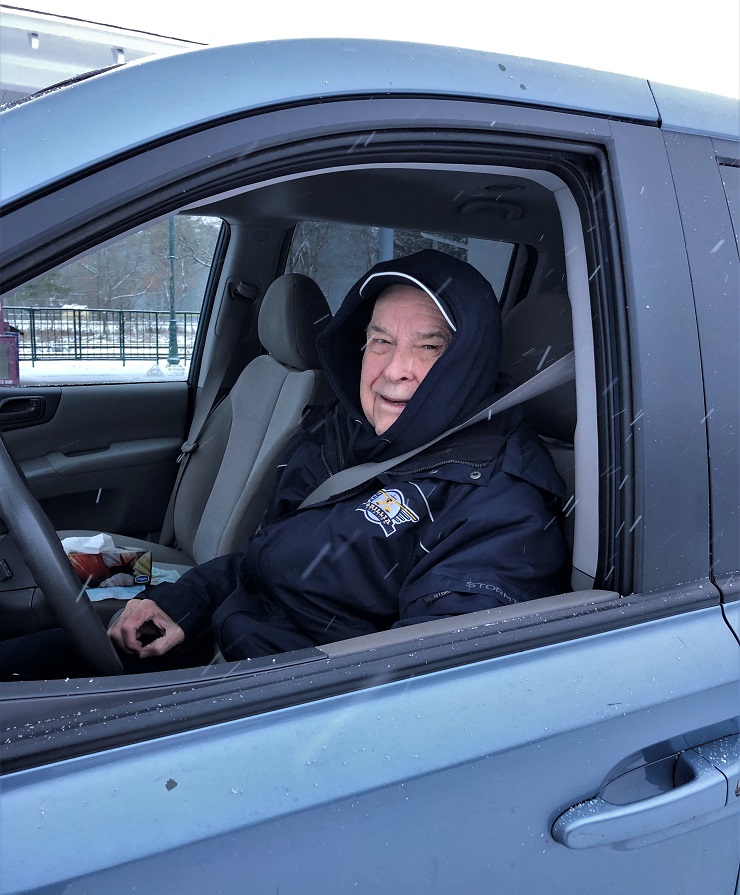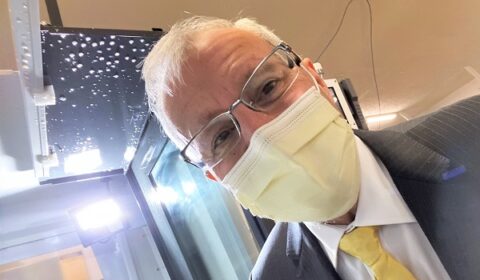FEDELI TALKS ABOUT NORTHLANDER RETURN AFTER TEST RUN LAST WEEK
Mark Clairmont | MuskokaTODAY.com
GRAVENHURST — Ontario’s latest flip-flop on electric vehicles indicates some real intent as to its return of the Northlander.
A few days after seven northereastern Ontario mayors made tracks for Toronto early one morning last week to meet with transportation minister Caroline Mulroney at Union Station to continue their pressure for a return to service, we spoke to Vic Fedeli the minister of economic development, job creation and trade.
He was back in Gravenhurst for a little longer than the pit stop he made to pick up Gravenhurst’s Mayor Paul Kelly.
During a visit to the Muskoka Airport to announce funding for a couple of local business expansion grants, the former mayor North Bay talked to MuskokaTODAY.com about his train trip and EVs.

Switching between the gas pedal and brake, he was adamant about the government’s commitment on the Northlander’s return; while charging ahead in saying the Ontario government prefers to put its money on the north’s natural resources as a way to best invest help the province and north grow its U.S. threatened automotive sector.
When Premier Doug Ford’s Conservative government came to office they put an end to both rebates and charging stations.
Rather than offer EV subsidies to car-buyers and to build them a network of charging stations to get drivers a few hours farther down the road.
Battery power is what drives EVs. And northern Ontario is full of resources that will make those ever ready bunnies cleanly hop along highways.
Fedeli said here last week: “We’re making big investments — billions — in the manufacturing of electric, vehicles which will require tens of thousands of employees.
“So that’s where we’ve chosen to use taxpayer dollars.
“What we’ve done is chosen to invest in the supply side. So all of those manufacturers. Now, we’re looking at the electric vehicle battery makers as well because, that again, will be tens of thousands of employees. That’s how we’re investing in clean energy, the green vehicles.
“Critical minerals — we’re making investments there. So we can mine the minerals to make the batteries to make the cars.”
That was last week.
Then two days ago, on Wednesday, Fedeli announced the “future of the automotive sector is shifting to electric vehicle production.”
He was in Markham to launch a “flagship program to drive innovation and investment across Ontario’s electric, connected and autonomous vehicle sector.”
Yesterday in King City to announce some EV charging stations along Hwys. 400 and 401, Fedeli said “this critical announcement in partnership with Ivy, ONroute and Canadian Tire means that Ontario will have the infrastructure in place to support the shift to more EVs on our roads.
“Through the second phase of our Driving Prosperity plan, our government is preparing Ontario to be a world-leader in the transition to EVs by closing deals for new automaker mandates for hybrid and battery EVs, attracting a new battery assembly plant to the province and increasing exports of Ontario-made auto parts and innovations around the globe.”
Mulroney added there: “With more electric vehicles coming onto our roads each year, it’s vital that drivers have the ability to conveniently charge their vehicles along the province’s busiest highways.”
See the test run story here.
See announcements below.
So now Ontario’s all aboard EVs — notably after Prime Minister Justin Trudeau’s automotive rebuff by U.S. President Joe Biden on larges slice of the automotive and EV pie for Canada going down the road.
And where does that leave stranded northerners seeking the “badly wanted” train service? Is there a light at the end of the Toronto train tracks when the government is investing so heavily on autos at the possible expense of commuter transit?
Is the will to drive people back in to their cars rather than rail?
Which is cleaner and greener in the long run?
Why this sudden turnaround — and now — after Fedeli told us otherwise last week?
Fedeli called the latest test run (there was previous one from North Bay to Cochrane) with seven mayors an “unqualified success.”
“I gotta tell you, there was nothing greater than to see a Northlander locomotive at Union Station again. It was just a historic moment for the first time in 10 years,” he said.
“I was very satisfied and I understand Ontario Northland was, too.”
Fedeli said the government has already committed $5 million for testing over two years.
“It’s all part of the operational budget to see the return of the Northlander.
He said the timing of next spring’s election has nothing to do with it and he blamed the previous government for shutting it down.
And a time frame?
“Hopefully we’ll see this roll out in the very near future.”
“I’ve always said we’re not going to be bound by a time frame. We just want to do this right. We want this back. We want it to be travelling at the right times. And so we’re not going to rush it.”
“It’s always been in the plan.”
See the video interview with Fedeli below.
‘Badly wanted service,’ says GAP member
A Nov. 28 column here in MuskokaTODAY.com about the reliability of the Northlander elicited this comment from John Cooper, of Gravenhurst, on behalf of GAP. He has been following the train saga with considered interest.
He called the Northlander a “badly wanted service,” in encouraging residents to meet the train Nov. 22. A dozen people — mostly councillors, train buffs and heritage supporters showed up for the train’s late arrival and one pickup of the mayor.

“Mark, kudos to you for the attached guest article, by Tara Collum, that addresses the harsh realities of living without a car, or access to, in a municipality that is small enough, that it is unable to efficiently offer public transportation! Tara points out precisely what GAP has been stating in countless lobbies.
“The article addresses many of the questions, but little in the way of answers. That is not a criticism, but the reality, that, there are no easy or obvious answers.
“The GAP transportation efforts to meet some of the needs of our disadvantaged, and so often stranded, customer base is mentioned. GAP is trying to expand this capability, with volunteer drivers, who are compensated with a mileage rate. This is in addition to GAP’s cab service, and gas card program.
“I have copied the members of our GAP transportation team and council members, and senior staff. This reality will not go away. Jeff Loney (Gravenhurst economic development officer) is securing some Ontario government grant money to have a consultant study Gravenhurst’s public transportation needs.”
However, he added in a further email comment:
“Your guest writer said what needed to be said. We have an expensively refurbished, locked up, railway station. Bracebridge has not a station, and Huntsville sold theirs off to private enterprise, years ago.
“Since ours has heritage designation, it will remain a town possession, even if it is never used, except for the two small portions that are rented to the taxi company, and the vet service.
“My provincially well-connected friends remind us that we have a provincial election in June, and that is what this talk is all about. Just prior to Ford being elected, the same talk was active, and it died right after the election.
“With no station in two Muskoka towns and one here that makes no economic sense without heavy subsidization, what do you think the chances are that we will have regular Toronto to North Bay service with three stops in Muskoka?
“Chances are somewhere between very slim, to none!”


EMAIL: news@muskokatoday.com
28 years of ‘Local Online Journalism’
Twitter: @muskokatoday, Facebook: mclairmont1
Leave comments at end of story
SUBSCRIBE for $25 by e-transferring to news@muskokatoday.com
Or go online to https://muskokatoday.com/subscriptions
EV CHARGING STATIONS FOR 400 AND 401 HIGHWAYS
KING CITY — Ontario is bringing electric vehicle (EV) fast chargers directly to the province’s busiest highways with the deployment of Ivy Charging Network chargers at all ONroute locations, says a release Thursday.
Chargers at 17 ONroute locations will be open in time for next summer, with another three ONroute locations opening before the end of 2022.
“Ontario is putting shovels in the ground to build critical infrastructure including highways,” said Todd Smith, Minister of Energy. “Our agreement with Ivy, ONroute and Canadian Tire to construct EV chargers at all of the province’s 23 ONroute stations is an important step forward, allowing EV owners to travel our great province with more freedom and confidence. This deployment will reduce barriers to EV ownership, supporting Ontario’s growing EV manufacturing market and critical minerals sector, and help achieve Ontario’s goal of building at least 400,000 electric and hybrid vehicles by 2030.”
The deployment of charging infrastructure will see ONroute locations along highways 401 and 400 equipped with at least two EV chargers at each site, with busier sites equipped with more. The EV chargers will be available to all drivers on a pay per use basis and will serve all vehicle types.
“With more electric vehicles coming onto our roads each year, it’s vital that drivers have the ability to conveniently charge their vehicles along the province’s busiest highways,” said Caroline Mulroney, Minister of Transportation. “In addition to building new highways that will alleviate congestion in Ontario, the installation of Ivy Charging Networks at all ONroute locations is a big step forward to support EV owners.”
These chargers will further encourage the electrification of the transportation sector in Ontario by making EV charging more accessible, and as the EV population grows more chargers may be added at each site. The electrification of the province’s vehicles will continue to reduce greenhouse gas emissions by shifting away from gas-powered vehicles and utilizing Ontario’s 94 per cent emissions-free electricity supply.
“I welcome the news on a further expansion of electric vehicle charging across the province. This joint venture signals Ontario’s continued efforts to drive down emissions in the province, while making electric vehicles more accessible to Ontarians,” said David Piccini, Minister of the Environment, Conservation and Parks. “Increased charging across Ontario ONroute locations means more opportunities for clean, green transportation in the future.”
This initiative builds on the government’s Driving Prosperity: The Future of Ontario’s Automotive Sector plan to create a domestic EV battery ecosystem in the province and position Ontario as a North American automotive innovation hub, by working to support the continued pivot to electric, low-carbon, connected and autonomous vehicles.
“The future of the automotive sector is shifting to electric vehicle production, and this critical announcement in partnership with Ivy, ONroute and Canadian Tire means that Ontario will have the infrastructure in place to support the shift to more EVs on our roads,” said Vic Fedeli, Minister of Economic Development, Job Creation and Trade. “Through the second phase of our Driving Prosperity plan, our government is preparing Ontario to be a world-leader in the transition to EVs by closing deals for new automaker mandates for hybrid and battery EVs, attracting a new battery assembly plant to the province and increasing exports of Ontario-made auto parts and innovations around the globe.”
‘FLAGSHIP PROGRAM’ FOR EVS AND AUTO SECTOR
MARKHAM — The Ontario government has launched a flagship program to drive innovation and investment across Ontario’s electric, connected and autonomous vehicle sector, it says in a release Dec. 2.
Its $56.4 million investment in the Ontario Vehicle Innovation Network (OVIN) is part of Driving Prosperity ― The Future of Ontario’s Automotive Sector, the government’s plan to drive deals and secure production mandates for hybrid and electric vehicles, create a domestic battery ecosystem, and strengthen Ontario’s position as a North American automotive and electric vehicle (EV) innovation hub.
At GM Canada’s Canadian Technical Centre (CTC) in Markham, Vic Fedeli, Minister of Economic Development, Job Creation and Trade announced the province’s latest commitment to putting Ontario at the forefront of global demand for cleaner, safer, more sustainable transportation solutions.
Delivered in partnership with the Ontario Centre for Innovation (OCI), OVIN is Ontario’s response to the rising global demand for EV and Connected and Autonomous Vehicle (CAV) technologies and infrastructure. Building on the success of previous programs that encourage partnerships between small- and medium-sized enterprises (SMEs), industry, academia and municipalities – OVIN will help to strengthen Ontario’s auto industry and make the province more competitive for new investments in EV and CAV technologies. It will act as Ontario’s hub for the province-wide coordination of activities and resources related to EV and CAV research and commercialization.
Combined with the province’s $85 million investment in the previous Autonomous Vehicle Innovation Network (AVIN), Ontario’s total investment in this flagship initiative is almost $142 million.
Together, Driving Prosperity and OVIN will position Ontario as a leading jurisdiction for new investments in for EV, CAV, battery technology, critical minerals and advanced manufacturing – reinforcing Ontario as the manufacturing hub of Canada.
“Ontario’s wheels are in motion to create a more sustainable future for the transportation sector. A critical pillar in our plan is strengthening Ontario’s position as an electric vehicle production hub, making these vehicles more accessible to drivers across the province,” said Caroline Mulroney, Minister of Transportation. “Our new flagship program will go a long way towards supporting our talented workforce, driving electric vehicle research and development, and reducing greenhouse gas emissions.”

